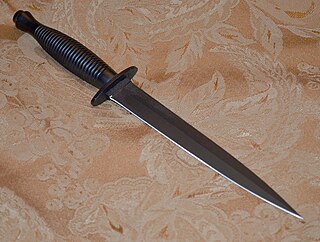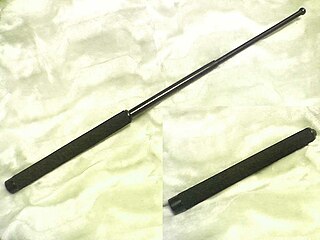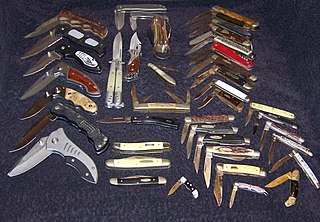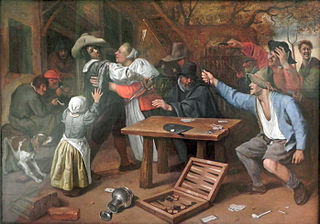
A dagger is a knife with a very sharp point and usually two sharp edges, typically designed or capable of being used as a thrusting or stabbing weapon. Daggers have been used throughout human history for close combat confrontations, and many cultures have used adorned daggers in ritual and ceremonial contexts. The distinctive shape and historic usage of the dagger have made it iconic and symbolic. A dagger in the modern sense is a weapon designed for close-proximity combat or self-defense; due to its use in historic weapon assemblages, it has associations with assassination and murders. Double-edged knives, however, play different sorts of roles in different social contexts.

The yawara is a Japanese weapon used in various martial arts. Numerous types of jujutsu make use of a small rod, made of wood, that extends somewhat from both ends of a person's fist which is known as a yawara. The yawara likely originated from the use of the tokkosho, a Buddhist symbolic object, by monks in feudal Japan. The tokkosho was used during the Edo period and it was made of brass. Sometimes a short "rope or cord" would be looped around the user's wrist to distract someone else while in combat. The methods of using a yawara may have been created by samurai that used tantojutsu, which was combat that made use of a short knife. According to another theory, a samurai might have fought with the scabbard "when a more deadly weapon was not necessary".

Filipino martial arts (FMA) refer to ancient Malay and newer modified fighting methods devised in the Philippines. It incorporates elements from both Western and Eastern Martial Arts, the most popular forms of which are known as Arnis, Eskrima, and Kali. The intrinsic need for self-preservation was the genesis of these systems. Throughout the ages, invaders and evolving local conflict imposed new dynamics for combat in the islands now making up the Philippines. The Filipino people developed battle skills as a direct result of an appreciation of their ever-changing circumstances. They learned often out of necessity how to prioritize, allocate and use common resources in combative situations. Filipinos have been heavily influenced by a phenomenon of cultural and linguistic mixture. Some of the specific mechanisms responsible for cultural and martial change extended from phenomena such as war, political and social systems, technology, trade and practicality.

Arnis, also known as Kali or Eskrima/Escrima, is the national martial art of the Philippines. The three are roughly interchangeable umbrella terms for the traditional martial arts of the Philippines, which emphasize weapon-based fighting with sticks, knives, bladed weapons, and various improvised weapons, as well as "open hand" techniques without weapons.

Self-defense is a countermeasure that involves defending the health and well-being of oneself from harm. The use of the right of self-defense as a legal justification for the use of force in times of danger is available in many jurisdictions.

A scalpel, or lancet, or bistoury, is a small and extremely sharp bladed instrument used for surgery, anatomical dissection, podiatry and various arts and crafts. Scalpels may be single-use disposable or re-usable. Re-usable scalpels can have permanently attached blades that can be sharpened or, more commonly, removable single-use blades. Disposable scalpels usually have a plastic handle with an extensible blade and are used once, then the entire instrument is discarded. Scalpel blades are usually individually packed in sterile pouches but are also offered non-sterile. Double-edged scalpels are referred to as "lancets".
Rex Applegate was an American military officer who worked for the Office of Strategic Services, where he trained Allied special forces personnel in close-quarters combat during World War II. He held the rank of colonel.

A strike is a directed physical attack with either a part of the human body or with an inanimate object intended to cause blunt trauma or penetrating trauma upon an opponent.

The sai is a traditional Okinawan melee weapon used for stabbing and blocking. It is used in ninjutsu and kobujutsu. The basic form of the weapon is that of a sharp metal prong with two curved sideprongs (yoku) projecting from the handle (tsuka). There are many different types of sai with varying prongs for trapping and blocking.
Flying discs can be thrown in many ways. Each throw involves snapping the wrist as well as flicking the arm to impart gyroscopic stability to the disc and accelerate its mass to a certain velocity. Without spin, a disc will wobble and fall; without velocity, the disc will not go anywhere. Using these two guidelines, any number of throws are possible. Most discs are designed to create lift when thrown with the flat side up.

A pocketknife is a foldable knife with one or more blades that fit inside the handle that can still fit in a pocket. It is also known as a jackknife (jack-knife) or a penknife, though a penknife may also be a specific kind of pocketknife. A typical blade length is 5 to 15 centimetres. Pocketknives are versatile tools, and may be used for anything from opening an envelope, to cutting twine, slicing a piece of fruit or even as a means of self-defense. They are often used as everyday carry (EDC) knives.
In cooking, a chef's knife, also known as a cook's knife, is a cutting tool used in food preparation. The chef's knife was originally designed primarily to slice and disjoint large cuts of beef. Today it is the primary general-utility knife for most western cooks.

Fencing – family of combat sports using bladed weapons. Fencing is one of four sports which have been featured at every one of the modern Olympic Games. Also known as modern fencing to distinguish it from historical fencing.

Pencak silat is an umbrella term for a class of related Indonesian martial arts. In neighbouring countries, the term usually refers to professional competitive silat. It is a full-body fighting form incorporating strikes, grappling and throwing in addition to weaponry. Every part of the body is used and subject to attack. Pencak silat was practiced not only for physical defense but also for psychological ends.

In martial arts, a knifehand strike is a strike using the part of the hand opposite the thumb, familiar to many people as a karate chop. This refers to strikes performed with the side of the knuckle of the small finger. Suitable targets for the knifehand strike include the mastoid muscles of the neck, the jugular, the throat, the collar bones, ribs, sides of the head, temple, jaw, the third vertebra, the upper arm, the wrist, the elbow, and the knee cap.

A knife fight is a violent physical confrontation between two or more combatants in which one or more participants is armed with a knife. A knife fight is defined by the presence of a knife as a weapon and the violent intent of the combatants to kill or incapacitate each other; the participants may be completely untrained, self-taught, or trained in one or more formal or informal systems of knife fighting. Knife fights may involve the use of any type of knife, though certain knives, termed fighting knives, are purposely designed for such confrontations – the dagger being just one example.
Jujutsu techniques include joint locks, chokeholds, strikes, grappling, throwing and other self-defense techniques.
The Warrior knife is a large curved blade fighting knife with a serrated back edge that was first made by Al Mar Knives and Round Eye Knife and Tool (REKAT). Part of the knife's design is credited to martial arts instructor Michael Echanis.
This is a glossary of terms used in fencing.

Jieitaikakutōjutsu is a military self-defence and fighting system developed for JSDF personnel. The system primarily consists of hand-to-hand combat, bayonet and knife fighting principles.













